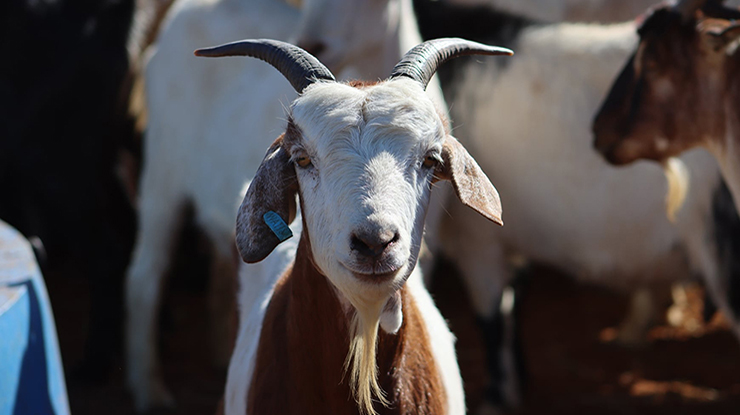 Image: Catlok Goats.
Image: Catlok Goats.
Moving goatmeat beyond ‘boom and bust’ cycle
Key points
- A new report has found the Australian goatmeat industry has the potential to move from a commodity supply chain to a market-orientated, consumer focused value chain.
- Goatmeat’s limited value-adding, product and market segmentation made it open to the ‘boom and bust’ of commodity cycles.
- Among the report’s recommendations are R&D investment designed to assist in the delivery of innovative on-farm solutions to guarantee consistency of supply to development of ready to cook products, and branding which differentiates flavour profiles.
The value of Australia’s goatmeat industry has the potential to be transformed through key interventions at different points across its supply chain, a new report has found.
The report, Developing a sustainable high-value market driven goat supply chain, was funded by MLA Donor Company (MDC) and led by Greenleaf Enterprises’ Dr Janine Teese and Ken Bryan, in collaboration with Cedar Meats.
It was undertaken to understand the international and domestic demand for goatmeat products and the technical trade barriers for new and existing products and markets.
Stakeholders in goatmeat supply chains wanted to understand market opportunities and the required supply chain interventions to develop value-added goatmeat products.
The findings from the report will provide insights to guide research and development (R&D) investment priorities and industry development activities by private sector, industry and governmental organisations.
Dr Teese said goats are becoming an integral part of rangeland production systems, together with beef and/or sheep as an income diversification strategy and land management tool.
“Producers who have diversified into goats are looking to develop their goatmeat business in alignment with market requirements and product specifications as per beef carcase grading and pricing grid specifications,” Dr Teese said.
“Taking a whole of chain approach from producer to processor to consumer, provides opportunities to identify and undertake whole-of-chain and point-specific interventions to uplift the entire chain and develop value-added products.”
Shift from ‘boom and bust’ cycles
The report found goatmeat’s limited value-adding, product and market segmentation made it open to the ‘boom and bust’ of commodity cycles.
Similar to where sheepmeat was 30 years ago, the goat industry can potentially move from a commodity supply chain to a market-orientated, consumer focused value chain with the required investment in R&D and marketing across the entire supply chain.
Indeed, the report found there is an opportunity for a $100 million to $140 million uplift in the export value of goatmeat each year by obtaining the average export price for 2022 of $12.28 per kilogram compared to the current average price for January to June 2023 of $7.38 per kilogram.
The $100 million dollar uplift is based on 2022 volumes, and the $140 million dollar uplift is based on 2023 export volumes year-to-date.
Additionally, new product development, further processing, packaging and branding will further increase the value and volume of goat exports.
Export opportunities
Goatmeat is predominately exported frozen as whole carcases or six-way cut carcase pieces from Australia. The United States is Australia’s largest market, with increased demand from other markets including South Korea and China in 2023 due to product availability at a lower price point.
The report found there is potential to develop value-added products and continue to supply to existing markets.
An irregular supply-base means processors are unable to sign more lucrative, longer term supply contracts and develop high margin markets. Flow-on effects include boom and bust cycles of an oversupply and low prices with spot market buyers trading off against mutton prices.
Innovative supply solutions combined with new product and market development provides an opportunity to break the commodity boom and bust cycles.
Markets exist for cubed products, grilling and roasting cuts, however the following factors have meant processors have maintained the status quo, selling a frozen carcase sliced six ways:
- a lack of goat-dedicated processing technology
- high processing costs per kilogram of meat sold
- workplace health and safety issues on bandsaws
- limited market development.
Understanding value attributes in different markets and aligning the supply chain to meet consumers’ needs, combined with innovation in processing, is required to develop a sustainable, high-value, market driven supply chain.
Recommendations and future research
Future R&D requires uplifting the entire supply chain to innovative on-farm solutions to guarantee consistency of supply to dedicated goat processing technology, branding and eating quality metrics which differentiates flavour profiles to ensure consumers are guaranteed a consistent eating experience.
The report recommends the development of innovative solutions to guarantee consistency of goat supply throughout the year, enabling processors to secure long-term supply contracts.
Examples include forward contracting producer consignments, coordinated mustering times with producers to link with processor supply windows, and supplementary feeding so goats kid at different times and maintain body condition.
The report also recommends investing in R&D focused on the introduction of automation into the goat processing sector to enable cubing and slicing the carcase into different cuts.
Development of a flavour profile system linked to carcase attributes and eating quality is another key recommendation. This will help producers and processors deliver a consistent eating experience, selected by the consumer for their recipe and cooking method.
Differentiating the flavour, carcase attributes and cut type to align with cooking method requires R&D at a market level while also developing systems for processors and producers to identify their target market.
The full report is available on the MLA website.



